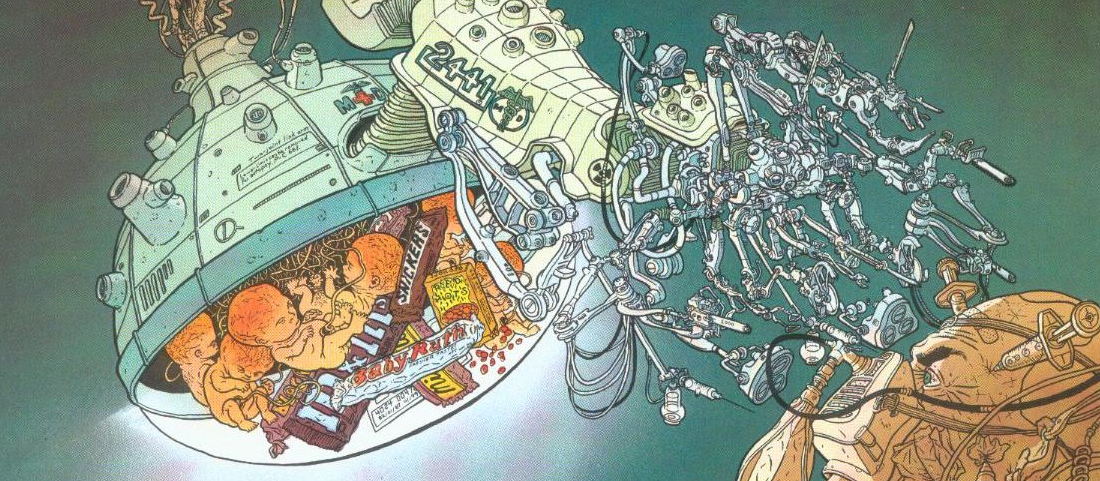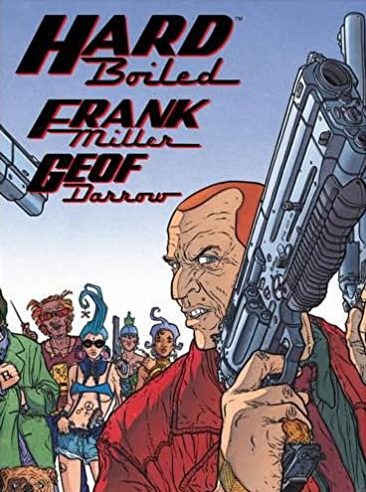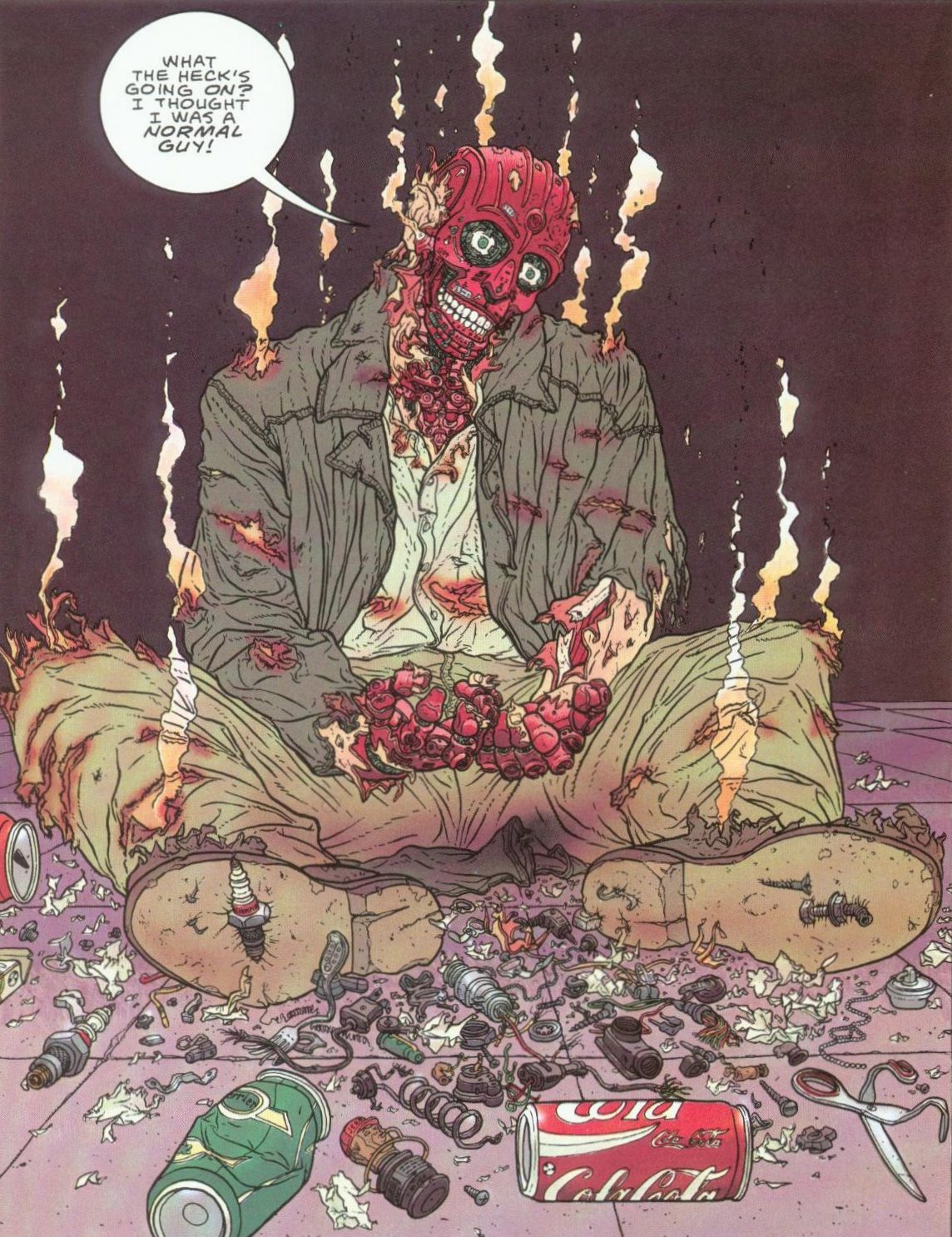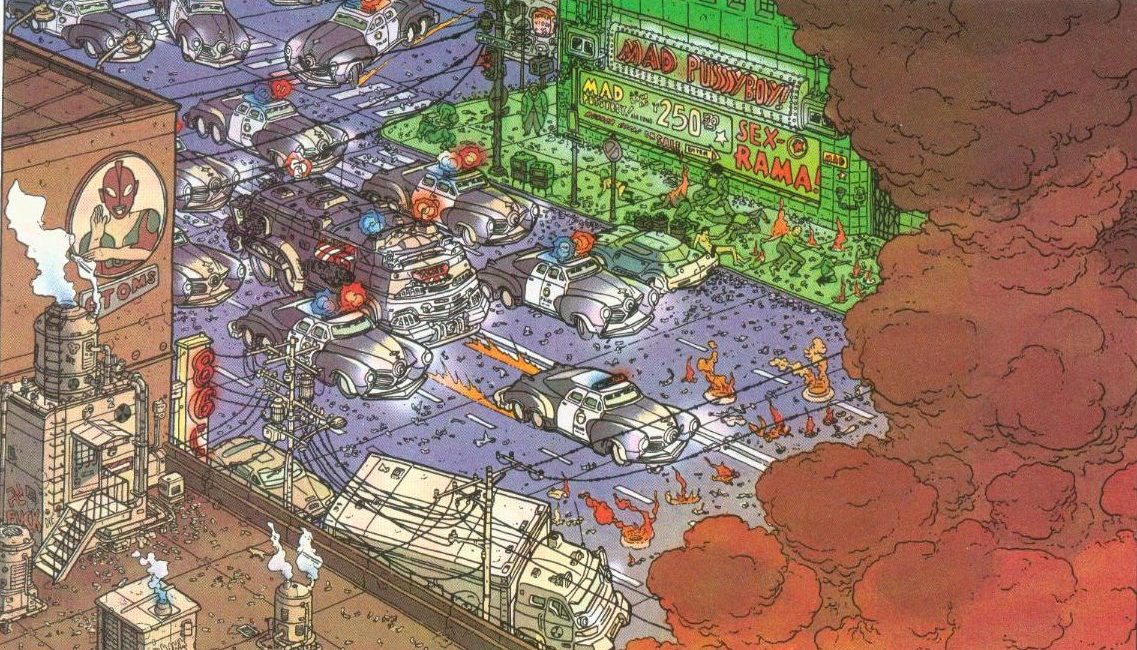

“There isn’t an ounce of flesh in you. Not a clump of brain matter. They feed you memories from dead men.”
Hard Boiled is a three-issue comic series written by Frank Miller and drawn by Geoff Darrow. Miller had already made a name for himself with his run on Marvel’s Daredevil, the Ronin miniseries for DC, and Batman: The Dark Knight Returns. But for Darrow, Hard Boiled helped launch his career. It was his American debut, and his gritty and hyper-detailed art style was such an inspiration to the Wachowskis that they asked him to storyboard The Matrix.
Like The Matrix, Hard Boiled is an action-packed cyberpunk story where the protagonist perceives a false reality as real. In Miller’s slim narrative, our anti-hero shifts between two personas, those of Nixon the tax collector and Carl Seltz the insurance investigator. In Darrow’s vision of a near-future dystopian Los Angeles, tax collection and insurance investigation apparently involve gruesome physical altercations on the regular. Luckily for Nixon, his body is nearly indestructible. He is able to take endless beatings because (in addition to suffering from multiple personality disorder) he is a robot. He was manufactured three months ago and his memories are a false amalgamation from various sources. Where Hard Boiled differs from standard mind-bending sci-fi is in its graphic depictions of excessive violence and depravity through a satirical lens. The book begins with Nixon sticking his foot through a car (a “Jesus Chrysler”). Soon thereafter he is on fire, with shards of glass sticking from his body; a car rams him through a brick wall; his fingers point in ways they should not. His injuries require extensive surgery, during which he fades in and out of consciousness, waking up as Carl Seltz. He flickers between realities as his “wife” seduces him and his children inject him with a sleep-inducing drug. Darrow and Miller certainly have some unique sensibilities.

As Nixon’s identity unravels, a plethora of debauched themes emerge. Willeford Home Appliances, which ostensibly is in the business of (duh) home appliances, has created a series of robot assassins to further their corporate interests. They are inorganic, but look, act, and think like they are human. When Carl has a violent encounter with a delinquent he has been instructed to track down, the carnage leaves her with patches of missing skin, revealing robotic parts underneath. Carl is forced to confront reality when his skin is pulled from his forearm and the word “Willeford” is engraved on the metal beneath it. Are his memories of his wife and children real? Is he Carl Seltz, Nixon, or Unit Four—the one to unify the robot uprising?
Despite being written by Miller, it’s really a vehicle for Darrow’s unique art style that looks like a cross between Katsuhiro Otomo’s Akira and Moebius’s The Incal. He depicts crushed metal, littered streets, and physical gore in great detail, and even draws several panels that call to mind “bullet time” from The Matrix. The setting is a richly detailed near-future dystopia in which large corporations dominate society and excessive consumerism has led to a depraved culture. Brand names, popular products, and pop culture references litter the pages, tying in with the story’s theme of corporate pervasion. Astro Boy, Porky Pig, Batman, Tweety Bird, Popeye, Bambi, Psycho, and The Flintstones are all present in the detailed layouts of Darrow’s panels. Cars are named after Sylvester Stallone and Clint Eastwood, giant soda cans ride atop others, and various other logos and brand names are plastered in every nook and cranny. Late in the third issue, Nixon is confronted by a gang of postmodern evangelists brandishing crucifixes in his face. Upon the cross in a blasphemous potential outcome of hyperconsumerism and commercial exploitation is the figure of Bart Simpson. The duo’s pessimistic worldview doesn’t always make complete sense, but this critique of consumers being unable to separate their identities from pop culture is spot on.

The story and themes are intriguing, but they are not substantial enough to carry Hard Boiled on its own. The comedic tone evident from the opening pages allows us to stomach peeling skin, defaced skulls, the barrel of a firearm stabbing through a limb, mangled fingers, etc. At only three issues and sparse on dialogue, the story works as a framework for Darrow’s grisly imagery, detailed setting, and rich themes which tell a large portion of the story. There is a neat little subplot involving a robot liaison at the Willeford laboratory that adds a twist on the familiar tale of self aware artificial intelligence, reversing the standard roles of humans and robots. As humans submit themselves to corporate exploitation, it is the machines that find intrinsic value in their lives, with the liaison going so far as to yearn for physical beauty and take her own life when her hope for freedom is lost.
The brief story is interesting, but the twisted alt-future and Darrow’s artwork are what make the book memorable. At times it’s reminiscent of Blade Runner (and its source story, Do Androids Dream of Electric Sheep?) or the sci-fi films of Paul Verhoeven (RoboCop, Total Recall, Starship Troopers), but with much less philosophical introspection and much more violence and depravity for their own sake. It’s a playful and flavorful romp that has all the right tropes, but is simply too slim to spend more than a few hours on.